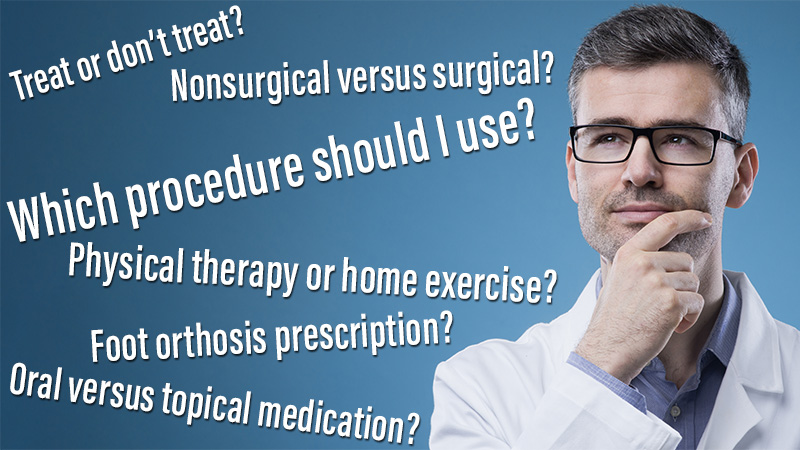
Practice Perfect 823
The Making Practice Perfect Decisions Series: An Introduction
The Making Practice Perfect Decisions Series: An Introduction

The life of any physician or surgeon is filled with decisions. Every patient treatment method requires us to make a decision. Treat or don’t treat. Nonsurgical versus surgical. Choice of procedure. Foot orthosis prescription. Oral versus topical medication. Physical therapy or home exercise. The list goes on and on and on. From the minute we wake up to the minute we fall asleep, our lives are jam packed full of decisions. Some of the decisions lead to positive outcomes and others to negative. Hopefully, on balance, our day lands on the positive side.
As an educator and someone trying to improve my own decision making as well as my trainees, I have found decision-making to be the single most important – and underappreciated – skill in medicine. If one were to examine the medical literature, it will be abundantly clear that making decisions is well studied in one indirect form or another. Looking at the outcomes of a particular procedure, for example, indirectly advocates for choosing that procedure – or eliminating it as an option – depending on the study results. Similarly, various algorithmic approaches have been adopted to treat certain pathologies.
However, what is lacking is the day to day, moment by moment, clear processes by which a physician should decide on a particular treatment method. Take plantar fasciitis as an example. We have a clinical practice guideline/consensus statement created by the American College of Foot and Ankle Surgeons on the diagnosis and treatment of heel pain1. But despite the list of treatment options available, from shoe changes all the way to surgical procedures, the guidelines are absent of a decision-making process. There’s no guiding thought process. It’s more of a menu of options to pick. As a result, we end up applying a “what works in my hands” method. I don’t think the buffet method of clinical choice yields the best results.
The clinical practice guideline/consensus statement created by the American College of Foot and Ankle Surgeons are absent of a decision-making process. They are more of a menu of options to pick.
Similarly, when one examines surgical outcomes, we don’t need to be in practice for long before seeing an unfortunate patient with continued pain after multiple surgeries. In my 17 years of clinical practice, I’ve seen more poor results from colleagues and some from myself than I care to recall (and admit!). There are three primary reasons for this.
- First, the uncontrollable and unfortunate “it just happened.” - For example, there is a published 5% rate of nonunions after the Lapidus bunionectomy2,3,4,5. Similarly, postoperative infections are reasonably common despite antiseptic technique. Keloids may form despite our best efforts to create cosmetic scars. Sometimes, there’s no good explanation (or the reason lies outside of our control); it just happens.
- Second, failures in technical performance - Not correcting a deformity or failure to apply hardware correctly can often lead to postoperative complications or poor outcomes. This is correctable for future patients by a resilient mind-set with further training and self-analysis.
- Third, and the most difficult and poorly understood, are failures in decision-making - An example of this is choosing the incorrect surgical procedure or prescribing a functional orthosis for a patient that needs an accommodative device. The number of potential mistakes we can make given incorrect decisions is astounding. These errors come from a large number of potential areas including a seemingly limitless number of biases, missing information, rushing due to lack of time or too many patients, pure incompetence, and lack of experience, among others.
If there are so many chances to make decision-related errors, why do we not have guidelines to help? Random chance can’t be fixed, technical errors can be minimized, but there’s very little done about decision-making issues, despite this being an area ripe for analysis. We are left with a sort of consensus model using experts with more experience than us, which is almost an apprenticeship method that says, “Do this because I said so.” We can rely instead on basic sciences or research literature to some extent, but they’re simply not enough. Why choose a Lapidus bunionectomy over an Austin procedure? Why pick an Evan’s osteotomy over a medial displacement calcaneal osteotomy? Ask any ten podiatric surgeons and you’ll receive at least that many opinions. Ask them why they chose such-and-such procedure, and you’re more likely than not to hear “it works well in my hands.” Do we really want to tell our patients that? We need something better…
Making Practice Perfect Decisions
If this is so difficult for practicing physicians (whether you admit it or not), imagine what it’s like for residents and students. We expect residents to choose procedures during academic discussions, clinic and surgery, but do we give them clear guidelines as to how to make those decisions? I don’t think so. Decision-making questions are the most common ones I ask my trainees and the hardest ones for them to answer.
Decision-making questions, as opposed to fact-base questions, are the most common ones I ask my trainees and the hardest ones for them to answer.
I have spent the last year observing the nonsurgical and surgical choices of various surgeons during my residency program’s academic sessions. I am incredibly lucky to have a number of excellent podiatric physicians and surgeons associated with the residency who are open and willing to discuss their procedures and examining outcomes, with an emphasis toward dissecting what was successful and what was not. During these discussions, I non-scientifically tracked procedure choices, successes, failures, and discussion points to see if I could pull out common themes that might lead, in the end, toward a set of decision-making rules.
From this subjective analysis, I have boiled the various recommendations down to ten primary rules that I will call Ten Rules for Making Practice Perfect Decisions. Hey, don’t get too critical! This blog is called Practice Perfect, so what do you think I’m going to call it?
This series will present one rule each week to help establish a thought process from which to work when making clinical decisions. I will endeavor to expand on each rule, explain as clearly as possible the important details of how each rule can be used. Before I list the rules, let me make a few disclaimers.
First, one should consider this an organic, non-static process that is subject to change as time goes by. We must be open-minded enough to realize when a particular rule should be adjusted.
Second, this is one person’s synthesis and not the product of a consensus panel. Obviously, there are better podiatric physicians than me and worse ones. I’m somewhere in the middle. Despite my bully pulpit here, the quality of these rules may be agreed on or disputed by others – and I welcome those discussions. I would love for these rules to become a starting point for future improvements rather than an end in themselves.
Third, one might imagine this can fit easily into an entire textbook on the subject, so keeping these issues somewhat concise for internet consumption also has limitations on the amount of detail that can be discussed. Maybe we’ll see a textbook on this in the future. Who knows?
Fourth, these are clearly not scientifically and rigorously validated and should be considered level 5 expert opinion. I strongly support anyone who uses these to create future research studies with the goal to improve all of our outcomes.
With that said, here are the Ten Rules for Making Practice Perfect Decisions:
Damaged/Strained Anatomy
Underlying Biomechanical Cause
and/or Correcting Deformity
Too Little Flexibility
There you have them, in all their glory. Ten rules to make decisions. Without giving away the details to be covered in future editorials, I’ll make just a few closing comments. I consider the first three rules to be golden, universal, and the most inclusive. In fact, I’ve written about them before, calling them the Kineticokinematic Approach (KK Approach)6. They will cover all nonsurgical decision making as well as starting off the surgical side of things. The rest are primarily surgically oriented, but others may find benefit in the nonsurgical realm as well. Finally, if you happen to have attended the PRESENT Podiatric Residency Education Summit East this past weekend, you will have heard a sneak peek review of the Ten Rules. If you missed it, consider coming to the PRESENT Podiatric Residency Education Summit Midwest September 9 to 11. I hope to see you there!
Best wishes.

Jarrod Shapiro, DPM
PRESENT Practice Perfect Editor
[email protected]

-
Schneider HP, Baca JM, Carpenter BB, Dayton PD, Fleischer AE, SachsBD. American College of Foot and Ankle Surgeons Clinical Consensus
Statement: Diagnosis and Treatment of Adult Acquired Infracalcaneal Heel Pain. J Foot Ankle Surg. 2018 Mar-Apr;1;57(2):370-381.
Follow this link -
Catanzariti A, Mendicino RW, Lee MS, Gallina MR. The Modified Lapidus Arthrodesis: A Retrospective Analysis. J Foot Ankle Surg. 1999 Sept-Oct;38(5):322-332.
-
Patel S, Ford F, Etcheverry J, Rush S, Hamilton G. Modified Lapidus Arthrodesis: Rate of Nonunion in 227 Cases. J Foot Ankle Surg. 2004 Jan-Feb;43(1):37-42.
-
Rink-Brune, O. Lapidus Arthrodesis for Management of Hallux Valgus - A Retrospective Review of 106 Cases. J Foot Ankle Surg. 2004 Sept-Oct;43(5):290-295.
-
Donnenwerth M, Borkosky SL, Abicht BP, Plovanich, Roukis TS. Rate of Nonunion after First Metatarsal-Cuneiform Arthrodesis Using Joint Curettage and Two Crossed Compression Screw Fixation: A Systematic Review. J Foot Ankle Surg. 2011 Nov-Dec;50:707-709.
-
Shapiro J. Surgical Biomechanics: Principles of Procedure Choice. ClinPodiatr MedSurg. 2020 Jan;37(1):101-116.
Follow this link
































Comments
There are 0 comments for this article